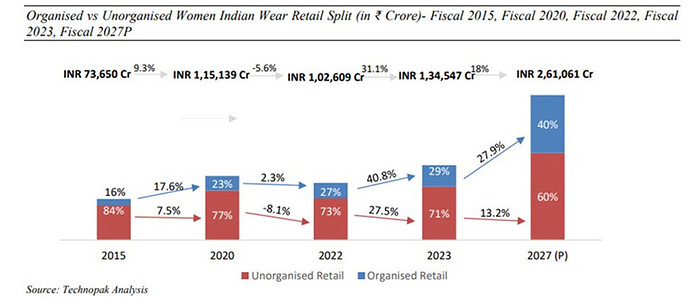Remember the last time you bought an Allen Solly shirt instead of a normal shirt at the mall or bought your first sketchers/woodland shoes in recent years. Nonetheless, you must have been buying Tata salt for many years. Yes, salt packed in plastic wrap and sold with the brand name, as trustworthy as Tatas, you have seen ubiquitously all around but never observed it.
As the famous character Sherlock Holmes’ famous saying goes – “You see, but you don’t observe”.
Upgrading the product/service you use or the intent to have high-quality service is what I call Premiumization. As this will be based on markets, we can dive into the companies where the behavioural changes in humans cause this megatrend. Trust me, it will poke you in your skull, saying, “Yeah, I have experienced this”.
This trend has been playing out for so many years, and we can base this on the behavioural need to humans to possess and experience better in life and feel rich using materialistic possessions, which has been ingrained in every cell of the body for hundreds of years.
Again, as I write this for the Indian audience, this is played out all around the globe, but, as investors, we can benefit from using the premiumization trend. With my bad habit of diving into history, a bit, and not boring you, before the 1991 economic reforms, India looked like this –
- Wait for the Bajaj scooter to reach your home after payment was 10 years.
- Opening a business requires government permission.
- Gold and global brands were smuggled into India – (remember the movie- Once Upon a time in Mumbai).
After the significant Dr. Manmohan Singh’s bold step in 1991, let’s check the past few out of the million instances in which companies have tapped into the pockets of consumers to increase their top line and significantly increase their bottom line by riding on the wave of human desire, greed, and jealousy, i.e., premiumization.
- Asian paints- becoming the largest player, taking away the market share of localised paint manufacturers. I bet you currently have no more than five options to buy paint for your house.
- Remember the fevi-quick add of getting fish on a wooden bar? Yeah, it’s the Pidilite Industries that premiumized glue.
- I remember we used to buy tea in weights from the local shop, and then we bought Red Label.
- The local milk delivery guy (carrying a big steel vessel) was replaced with the Amul milk delivery guy.
- As Indians, we went from-
- Sonata to Fastrack
- Splender to Bullet
- Rupa to Jockey
- Fan to AC
- Soap bar to liquid handwash
- Nokia to iPhone
- Bidi to cigarettes
- Desi to Royal Stage to Johnie Walker
- ……… and you can add whatever you experience.
Though many things will not make sense, but brands create a sense of deprivation and dopamine-kicking experiences when you purchase their products. For example, one of my friends will explain why the iPhone is not worth buying but will vouch for liquid handwash rather than soup. Whatever scientific evidence you provide, it does not make a difference; his mental abilities are biased on hygienic parameters, which he defines as good or bad. However, investors made a lot of money in Apple (iPhone), ITC (Cigarettes), Titan (Tanishq), Page Industries (Jockey), Eicher Motors (Bullet), LVMH (Louis Vuitton), etc.
So, let’s start the speculation of the future winner –
- Pricol – premiumization of your speedometer in your vehicle
- Titan – Jewelry from a brand
- Vedant Fashions – Wedding clothes (Manyavar)
- Tata Consumer – premiumization of millets, tea, rice and atta.
- Ethos - world class luxury watch brands; adding more Swiss and German brands to their portfolio.
- RACL Geartech – Premium auto component parts
- Metro brands – Shoes for high-end individuals
- Sula vineyards – Wine drinking population of India to Advance
- Radico Khaitan, United Spirits – Alcohol and drinks
- Zomato – Premium services of home delivery
- Tata Motors – Love for Mini SUV in India, and that led Maruti to add more SUVs in their basket of products.
- Nestle – Premium milk powder for children chosen by their mothers.
- Mankind Pharma – Premium condoms
- Aditya Birla Fashion and Retail Limited – Clothes
- UNO Minda – Alloy wheels for your car and information systems
- Mahindra Holiday, Wonderla – Outing with family and friends
- Dr Lal Path Labs – Premium medical services – especially testing
- Rainbow Children hospital – Premium hospitals desired by working parents if their earnings are high.
- Polycab, Finolex Cables — High-end electrical products, Smart switches, smart lock, etc.
- Nesco – Premium office spaces
- Inflame Appliances - Kitchen chimney, Hobs & cooktops, etc. - A play on penetration with variety of product portfolio.
- Phoenix Mills — Opening of malls in different cities, premiumization of shopping experiences.
Why the economies favor buying these companies –
- The customer does care about the price and pays a premium to possess the item.
- Hence, the profit margins are high.
- India’s per capita is increasing, which leads to higher disposable income and higher spending on luxury items.
- High influence of western culture in India.
Supporting evidence of the trend –
-
Increasing trend of organised retail in women shopping and continuous increase of the size of the pie simultaneously
-
SUV car market share in India increasing from 43% in September 2022 to 52% in October 2023.
A tweet to sink in and think about :
---------------------------------------------------------------------------------------------------------------------------
This will be updated personally; however, I published this as I will not have time recently. Also, thanks to SOIC, Raj Shamani, Nikhil Kamath and many more people I follow for getting this idea
Disclaimer: I am not SEBI registered. Nothing discussed above is a buy or sell recommendation*.*




